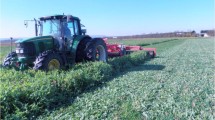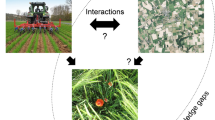Abstract
Amongst the biodiversity components of agriculture, weeds are an interesting model for exploring management options relying on the principle of ecological intensification in arable farming. Weeds can cause severe crop yield losses, contribute to farmland functional biodiversity and are strongly associated with the generic issue of pesticide use. In this paper, we address the impacts of herbicide reduction following a causal framework starting with herbicide reduction and triggering changes in (i) the management options required to control weeds, (ii) the weed communities and functions they provide and (iii) the overall performance and sustainability of the implemented land management options. The three components of this framework were analysed in a multidisciplinary project that was conducted on 55 experimental and farmer’s fields that included conventional, integrated and organic cropping systems. Our results indicate that the reduction of herbicide use is not antagonistic with crop production, provided that alternative practices are put into place. Herbicide reduction and associated land management modified the composition of in-field weed communities and thus the functions of weeds related to biodiversity and production. Through a long-term simulation of weed communities based on alternative (?) cropping systems, some specific management pathways were identified that delivered high biodiversity gains and limited the negative impacts of weeds on crop production. Finally, the multi-criteria assessment of the environmental, economic and societal sustainability of the 55 systems suggests that integrated weed management systems fared better than their conventional and organic counterparts. These outcomes suggest that sustainable management could possibly be achieved through changes in weed management, along a pathway starting with herbicide reduction.


Similar content being viewed by others
References
ADEME (2011) Guide des valeurs Dia‘terre. Version du référentiel 1.13. Agence de l’Environnement et de la Maîtrise de l’Energie http://www2.ademe.fr/servlet/KBase. Accessed 2013 July 12
Altieri MA, Nicholls CI, Ponti L (2009) Crop diversification strategies for pest regulation in IPM systems. In: Radcliffe EB, Hutchison WD, Cancelado RE (eds) Integrated pest management, concepts, tactics, strategies and case studies. Cambridge University Press, Cambridge, pp 116–130
Anderson RL (2007) Managing weeds with a dualistic approach of prevention and control. A review. Agron Sustain Dev 2:13–18
Aubertot J-N, Robin M-H (2013) Injury Profile SIMulator, a qualitative aggregative modelling framework to predict crop injury profile as a function of cropping practices, and the abiotic and biotic environment. I. Conceptual bases. PLoS one 8:e73202
Bastiaans L, Paolini R, Baumann DT (2008) Focus on ecological weed management: what is hindering adoption? Weed Res 48:481–491
BCMA (2012) Simcoguide online decision tool http://simcoguide.pardessuslahaie.net/#accueil Bureau de Coordination du Machinisme Agricole. Accessed 2013 April 12
Bohan DA, Boursault A, Brooks D, Petit S (2011) National-scale regulation of the weed seedbank by carabid predators. J Appl Ecol 48:388–398
Bohan DA, Raybould A, Mulder C, Woodward G, Tamaddoni-Nezhad A, Bluthgen N, Pocock M, Muggleton S, Evans DM, Astegiano J, Massol F, Loeuille N, Petit S, Macfadyen S (2013) Networking Agroecology. Adv Ecol Res 49:2–67
Boissinot F, Mézière D, Bretagnolle V, Munier-Jolain N (2011) Réduire l’usage des herbicides en grandes cultures. Le cas de la zone atelier «Plaine et Val de Sèvre». Phytoma 649:39–44
Bommarco R, Kleijjn D, Potts SG (2013) Ecological intensification: harnessing ecosystem services for food security. TREE 28:230–238
Brooks DR, Storkey J, Clark SJ, Firbank LG, Petit S, Woiwod IP (2012) Trophic links between functional groups of arable plants and beetles are stable at a national scale. J Anim Ecol 81:4–13
Chagnon M, Kreutzweiser D, Mitchell EA, Morrissey CA, Noome DA, Van der Sluijs JP (2014) Risks of large-scale use of systemic insecticides to ecosystem functioning and services. Environ Sci Pollut Res Int. doi:10.1007/s11356-014-3277-x
Chikowo R, Faloya V, Petit S, Munier-Jolain NM (2009) Integrated Weed Management systems allow reduced reliance on herbicides and long term weed control. Agric Ecosyst Environ 132:237–242
Colbach N, Collard A, Guyot SHM, Mézière D, Munier-Jolain NM (2014) Assessing innovative sowing patterns for integrated weed management with a 3D crop: weed competition model. Eur J Agron 53:74–89
Corbeels M, de Graaff J, Ndah TM, Penot E, Baudron F, Naudin K, Andrieu N, Chirat G, Schuler J, Nyagumbo I, Rusinamhodzi L, Traore K, Mzoba HD, Adolwa IS (2014) Understanding the impact and adoption of conservation agriculture in Africa: A multi-scale analysis. Agric Ecosyst Environ 187:155–170
Crowder D, Jabbour R (2014) Relationships between biodiversity and biological control in agroecosystems: current status and future challenges. Biol Control 75:8–17
Davis AS, Hill JD, Chase CA, Johanns AM, Liebman M (2012) Increasing cropping system diversity balances productivity, profitability and environmental health. PLoS One 7(10):e47149
Debaeke P, Munier-Jolain N, Bertrand M, Guichard L, Nolot JM, Faloya V, Saulas P (2009) Iterative design and evaluation of rule-based cropping systems: methodology and case studies. Agron Sustain Dev 29:73–86
Deytieux V, Nemecek T, Knuchel RF, Gaillard G, Munier-Jolain NM (2012). Is integrated weed management efficient for reducing environmental impacts of cropping systems? A case study based on life cycle assessment. Eur J Agron 36:55–65
Doré T, Makowski D, Malezieux E, Munier-Jolain N, Tchamitchian M, Tittonell P (2011) Facing up to the paradigm of ecological intensification in agronomy: revisiting methods, concepts and knowledge. Eur J Agron 34:197–210
Ekroos J, Hyvonen T, Tiainen J, Tiira M (2010) Responses in plant and carabid communities to farming practices in boreal landscapes. Agric Ecosyst Environ 135:288–293
Foley JA, Defries R, Asner GP, Barford C, Bonan G, Carpenter SR, Chapin FS, Coe MT, Daily GC, Gibbs HK, Helkowski JH, Holloway T, Howard EA, Kucharik CJ, Monfreda C, Patz JA, Prentice IC, Ramankutty N, Snyder PK (2005) Global consequences of land use. Science 309:570–574
Fried G, Kazakou E, Gaba S (2012) Trajectories of weed communities explained by traits associated with species response to management practices. Agric Ecosyst Environ 158:147–155
Gaba S, Bretagnolle F, Rigaud T, Philippot L (2014) Managing biotic interactions for ecological intensification of agroecosystems. Front Ecol Evol 2:29. doi:10.3389/fevo.2014.00029
Gabriel D, Thies C, Tscharntke T (2005) Local diversity of arable weeds increases with landscape complexity. Perspect Plant Ecol Evol Syst 7:85–93
Gardarin A, Dürr C, Colbach N (2012) Modeling the dynamics and emergence of a multispecies weed seed bank with species traits. Ecol Model 240:123–138
Garnett T, Appleby MC, Balmford A, Bateman IJ, Benton TG, Bloomer P, Burlingame B, Dawkins M, Dolan L, Fraser DM, Herrero I, Hoffmann P, Smith PK, Thornton C, Toulmin SJ, Vermeulen H, Godfray CJ (2013) Sustainable intensification in agriculture: premises and policies. Science 341(6141):33–34
Gravesen L (2003) The Treatment Frequency Index: an indicator for pesticide use and dependency as well as overall load on the environment. Reducing pesticide dependency in Europe to protect health, environment and biodiversity, Copenhagen, Pesticides Action Network Europe (PAN), Pure Conference
Gunton RM, Petit S, Gaba S (2011) Functional traits relating arable weed communities to crop characteristics. J Veg Sci 22:341–350
Holzschuh A, Steffan-Dewenter I, Tscharntke T (2008) Agricultural landscapes with organic crops support higher pollinator diversity. Oikos 117:354–361
Lechenet M, Bretagnolle V, Bockstaller C, Boissinot F, Petit M-S, Petit S, Munier-Jolain NM (2014) Reconciling pesticide reduction with economic and environmental sustainability in arable farming. PLoS One 9:e97922
Liebman M, Gallandt ER (1997) Many little hammers: ecological management of crop–weed interactions. In: Jackson LE (ed) Ecology in agriculture. Academic Press, San Diego, pp 291–343
Marshall EJP, Brown VK, Boatman ND, Lutman PJW, Squire GR, Ward LK (2003) The role of weeds in supporting biological diversity in crop fields. Weed Res 43:77–89
Mézière D, Lucas P, Granger S, Colbach N (2013) Does integrated weed management affect the risk of crop diseases? A simulation case study with a grass weed and a soil-borne cereal disease. Eur J Agron 47:33–43
Mézière D, Petit S, Granger S, Biju-Duval L, Colbach N (2014) Developing a set of simulation-based indicators to assess harmfulness and contribution to biodiversity of weed communities in cropping systems. Ecol Indic 48:157–170
Munier-Jolain NM, Guyot SHM, Colbach N (2013) A 3D model for light interception in heterogeneous crop: weed canopies. Model structure and evaluation. Ecol Model 250:101–110
Navas M (2012) Trait-based approaches to unravelling the assembly of weed communities and their impact on agro-ecosystem functioning. Weed Res 52:479–488
OECD (2001) Environmental indicators for agriculture. Methods and Results, vol 3. OECD publications, Paris, France
Oerke E (2006) Crop losses to pests. J Agric Sci 144:31–43
Pardo G, Riravololona M, Munier-Jolain NM (2010) Using a farming system model to evaluate cropping system prototypes: are labour constraints and economic performances hampering the adoption of integrated weed management? Eur J Agron 33:24–32
Perronne R, Gaba S, Cadet E, Le Corre V (2014) The interspecific and intraspecific variation of functional traits in weeds: diversified ecological strategies within arable fields. Acta Bot Gallica Bot Lett. doi:10.1080/12538078.2013.868320
Petit S, Boursault A, Le Guilloux M, Munier-Jolain NM, Reboud X (2011) Weeds in agricultural landscapes: a review. Agron Sustain Dev 31:309–317
Petit S, Alignier A, Colbach N, Joannon A, Thenail C (2013) Weed dispersal by farming activities across spatial scales. Agron Sustain Dev 33:205–217
Phalan B, Onial M, Balmford A, Green R (2011) Reconciling food production and biodiversity conservation: land sharing and land sparing compared. Science 333:1289–1291
Reganold JP, Palmer AS, Lockhart JC, Macgregor AN (1993) Soil quality and financial performance of biodynamic and conventional farms in New Zeland. Science 260:344–349
Ricou C, Schneller C, Amiaud B, Plantureux S, Bockstaller C (2014) A vegetation-based indicator to assess the pollination value of field margin flora. Ecol Indic 45:320–321
Seufert V, Ramankutty N, Foley JA (2012) Comparing the yields of organic and conventional agriculture. Nature 485:229–232
Storkey J, Cussans JW (2007) Reconciling the conservation of in-field biodiversity with crop production using a simulation model of weed growth and competition. Agric Ecosyst Environ 122:173–182
Storkey J, Brooks D, Haughton A, Hawes C, Smith BM, Holland JM (2013) Using functional traits to quantify the value of plant communities to invertebrate ecosystem service providers in arable landscapes. J Ecol 101:38–46
Trichard A, Alignier A, Biju-Duval L, Petit S (2013) The relative effects of local management and landscape context on weed seed predation and carabid functional groups. Basic Appl Ecol 14:235–245
Tuck SL, Winqvist C, Mota F, Ahnström J, Turnbull LA, Bengtsson J (2014) Land-use intensity and the effects of organic farming on biodiversity: a hierarchical meta-analysis. J Appl Ecol 51:746–755
Ulber L, Steinmann HH, Klimek S, Isselstein J (2009) An on-farm approach to investigate the impact of diversified crop rotations on weed species richness and composition in winter wheat. Weed Res 49:534–543
van der Werf HMG, Zimmer C (1998) An indicator of pesticide environmental impact based on a fuzzy expert system. Chemosphere 36:2225–2249
Wilson JD, Morris AJ, Arroyo BE, Clark SC, Bradbury RB (1999) A review of the abundance and diversity of invertebrate and plant foods of granivorous birds in northern Europe in relation to agricultural change. Agric Ecosyst Environ 75:13–30
Acknowledgments
We thank the two anonymous reviewers for their constructive comments on an earlier version of this paper. The ANR project Advherb STRA-08-02 ‘Agroecological management of arable weeds’ was funded by the French Agence Nationale de la Recherche. Delphine Mézière and Martin Lechenet were funded by the project. We are very grateful to all the farmers who have contributed to the project, as well as to Marie-Sophie Petit and all the other persons that were involved in the work that was conducted in the different experimental farms in Burgundy.
Author information
Authors and Affiliations
Corresponding author
Appendices
Appendix 1
See Table 5.
Appendix 2
List of the 16 weed species modelled in the FLORSYS model.
Alopecurus myosuroides
Amaranthus retroflexus
Avena fatua
Capsella bursa-pastoris
Chenopodium album
Echinochloa crus-galli
Fallopia convolvulus
Galium aparine
Geranium dissectum
Polygonum aviculare
Polygonum persicaria
Senecio vulgaris
Solanum nigrum
Sonchus asper
Stellaria media
Veronica hederifolia
Rights and permissions
About this article
Cite this article
Petit, S., Munier-Jolain, N., Bretagnolle, V. et al. Ecological Intensification Through Pesticide Reduction: Weed Control, Weed Biodiversity and Sustainability in Arable Farming. Environmental Management 56, 1078–1090 (2015). https://doi.org/10.1007/s00267-015-0554-5
Received:
Accepted:
Published:
Issue Date:
DOI: https://doi.org/10.1007/s00267-015-0554-5




